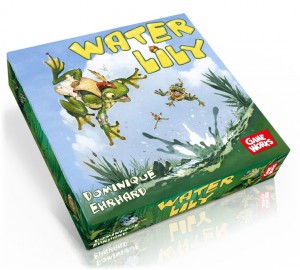Review: Water Lily
Posted by James (admin) on November 3rd, 2010
 Water Lily is a very simple game and short enough be a filler but there’s a lot more fun to this than you may expect due to the clever scoring system.
Water Lily is a very simple game and short enough be a filler but there’s a lot more fun to this than you may expect due to the clever scoring system.
The goal is to move your colour frogs so they score the most victory points (VPs). There are 4 frogs in each of the 5 colours and each player is secretly allocated a colour so they don’t know which colours the other players are.
Players take turns moving the top-most frog on a space (there can be up to 4 on any space) in a straight line. The frog can be moved a number of spaces equal to or less than the number of the frogs on the space it moves from. So, if there are 3 frogs on a space, you can move the top-most frog up to 3 spaces.
If you look at the picture of the game above you will see that there are slots at the far side of the game board. When a frog reaches the end of the board, it is posted down the relevant slot so that it slides down sloped channels which are hidden by the card cover on top. (The sloped channels are in the box base an the main game board is placed on the box lid.) The order of the frogs in the slots will determine how many points each frog scores.
The game ends as soon as one colour of frog is completely removed from the board. At this point, the card covering the slots is lifted and the total VPs of each player is added up. Each slot has numbers 1 to 4 from the bottom up and a frog scores the points equal to its row. However, any frogs after the 4th one score zero points. So, the later you slide a frog down a slot, the more points it could score but you risk scoring zero.
 Overall, Water Lily is simple and fast to play but delivers more content than you would expect. The scoring system is very cool because of the hidden slots with the increasing (but limited) points values. It’s not as easy as you may think to track exactly where the frogs have already gone so there is a superb pay-off between grabbing fewer-but-definite points early or aiming for greater points later with the risk of moving too late and scoring zero. Also, there’s some gameplay is pushing opponents’ frogs down the slots to make them score fewer points and increase your possible points.
Overall, Water Lily is simple and fast to play but delivers more content than you would expect. The scoring system is very cool because of the hidden slots with the increasing (but limited) points values. It’s not as easy as you may think to track exactly where the frogs have already gone so there is a superb pay-off between grabbing fewer-but-definite points early or aiming for greater points later with the risk of moving too late and scoring zero. Also, there’s some gameplay is pushing opponents’ frogs down the slots to make them score fewer points and increase your possible points.
The game end is interesting because players can manipulate it – moving one colour off the board to speed up game end, or pinning down a colour (by placing a frog on top of another) to stop a colour moving off the board. Whilst you try not to move your pieces too obviously (in case you give away your colour too early), you don’t want to leave it too late as the game can end before you’ve got many of your frogs down the slots.
The game plays 2 to 4 players and I found it worked equally as well with 2-players as it did with 4. Playing with more players may have the slight edge because more frogs are moved between your turns which means you need to plan even more carefully. I was pleased that it is still very good with 2 players.
There really aren’t any obvious downsides to the game although I think there may be a missed opportunity to have increased the variety between the games by having customisable score tracks (i.e. changing the order of each of the score tracks) and even having secret objectives (i.e. +3 points if you no frogs scoring 1 point). I’m not sure the game needs to be in such a big box but it’s not a problem that it is.
I must confess that I wasn’t expecting much from Water Lily as I didn’t know much about it. It turns out that Water Lily is simple, fast and good fun. There always seems to be an excited anticipation when the game ends and players get to see what they scored. Very nice indeed.
James.
[Played with 2 and 4 players]
Note: Water Lily was a review copy given to me by Game Works.

